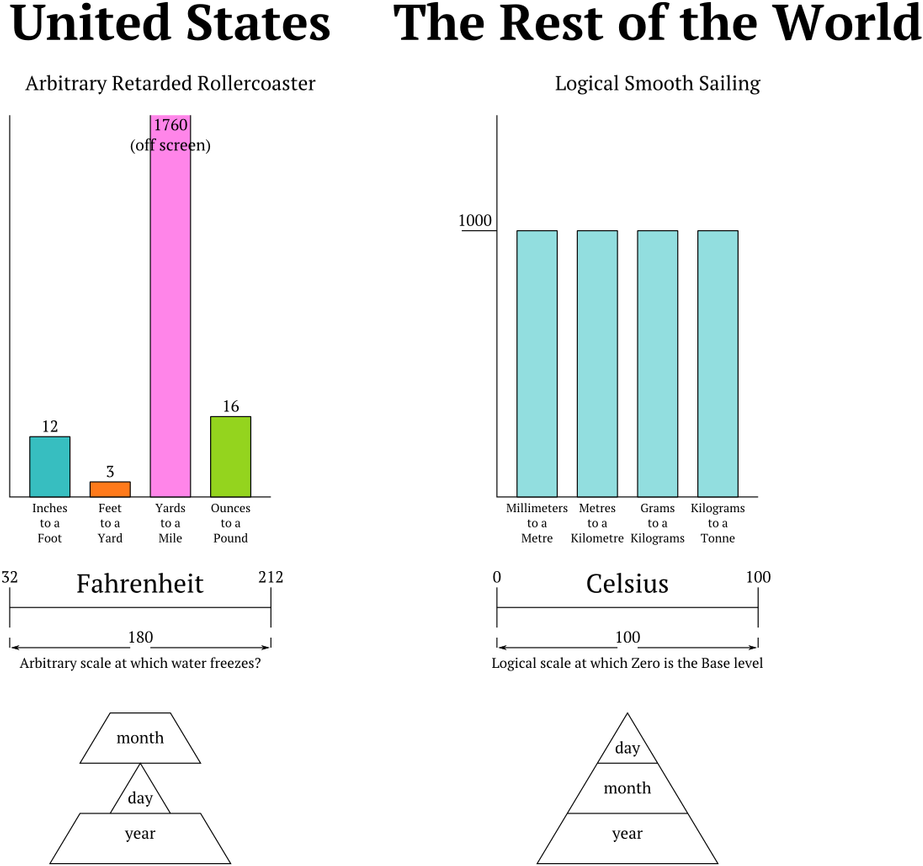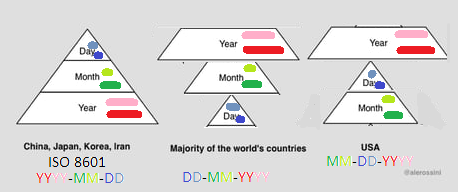Actual poster from 1917 that made me laugh. A lot.
Also, those motherfuckers are measuring the weight of those balls in kilograms, aren’t they?

I believe in some countries in the world, the year goes first, then the month, then the day (2024/08/08 or 2024, August 8). Seems more logical to me than the literal inverse (08/08/2024 or 8 August 2024).
But yeah, the metric system reigns supreme.
Year, month, day is the most logical. I’ll stand by month, day, year as being more logical than day, month, year because it’s somewhat more sorted lol.
How in the world is (month/day/year) more sorted than (day/month/year)? I see two use-cases: Sorting things chronologically, in which case you want YYYY/MM/DD, or referring to nearby dates, where the year or even month can be assumed known implicitly, in which case you use DD/MM/YYYY. In no sane world does MM/DD/YYYY make sense.
Because you put big numbers first! Three hundred twenty one is written 321 not 1, 20, and 300. 21 and 300 is more sorted. MM/DD/YYYY only has one element out of place instead of being totally backwards.
Big numbers first is not the only way to sort - look at say how they sort the speeds of runners in a race.
If it is “backwards”, it is sorted, in reverse order. If it has an element out of place it is not sorted.
It’s only when they extend to hh:mm:ss dd/mm/yyyy that it becomes assorted. They need to fully commit and either use tzmm:tzhh+ fff.ss:mm:hh dd/mm/yyyy or just use fucking iso 8601. Fuck everyone who doesn’t; fuck M$, fuck oracle, fuck humans.
Runners use minutes before seconds
I mean, I’m fine with the long form (August 8, 2024), but definitely not the short form, which today looks indistinguishable from DD/MM/YYYY anyway. I often think it’s the other way around and ask “since when was there a 26th month??”.
I would’ve mentioned it but I forgot what it’s called. Thanks for reminding me.

Wouldn’t the second one make more sense as an upside down pyramid?
Because the first digit in each of the numbers is larger than the second digit it would be the triple inverted pyramid as shown, where the larger numbers correspond to larger sub-pyramids and larger digits correspond to the larger side of the sub-pyramid.
The colored text and marks on the pyramids are to show that.
I imagined, but I was too lazy to actually look at the colors lol. Thanks for explaining :)
What was the point for this propaganda? To keep products incompatible somehow?
Relabeling is such a chore.
Replacing all your tools and machines is super easy, though. /s
FWIW I only work in metric, Imperial is utter trash, tbh.
Well we already deal with a mixed system, so they could relabel where possible and just phase out any machines where not, and in the interim just hand out slide rules with conversions on them.
Why don’t you want to measure things by parts of a twelfth of a Roman foot?
of an approximation of a derivative of the Roman foot in metric*
The Roman foot was between approximately 0.96 and 1.1 international feet (most commonly about 0.97 ft, except in modern Belgium where it was 1.091 ft/13.1 in, the size of Nero Claudius Drusus’ foot). After that, the foot in Britain was based off the North German foot (~13.2 in), but in the late 13th century it became more like 12 in (so around the same as the modern foot). Later the English foot was between 11.7 and 12.01 in, and the US foot was based on the English foot until the 19th century when they made the US Customary Units and defined the foot as exactly 1200/3937 meters. The British made the British Imperial system and a bit later defined the foot as 1200/3937.0113 meters. They didn’t switch to metric because they saw “French Revolutionary units” (metric) as “atheistic”. Later, we advanced our understanding of physics, and the British adopted a foot of 304.8 mm in 1930, and the Americans followed them in 1933, based on the new “industrial inch” from the now-unused 1927 light wave definition of the meter (which used the International Prototype, made of a standard bar). The modern foot is defined as exactly 0.3048 meters, by international agreement in 1959 between some English-speaking countries, after the newer Kypton standard definition of the meter (which is also now not used).
The really neat thing about those changes to the meter is that it didn’t really change how long a meter was (-ish), it changed the precision of that definition, as well as the ability to reproduce an exact meter, reducing the need for a specific piece of material to define the meter (which changes length based on environment). Now, an exact standard meter can be reproduced independently in any lab with the proper equipment.
What’s especially wild is that the kilogram was still an artifact in 2019! Every single calibrated weight in the world, big and small… They all could be traced back to a single metal chunk in a french vault.
Capital owners that don’t want to retool for a bullshit reason like “common good”.
It literally costs them more money to not use the global standards!
In the long run, maybe. short term is all that matters. And short term it costs money
What ‘has’ we done. Well, they didn’t go to school, that’s for sure. And clearly they didn’t send their kids to school either, as it’s a damn old poster and it’s been more then a hundred years while the US still uses imperial.
There is literally a W right over that H to compare it to.
Yeah, I down voted my own comment.
Kudos for leaving it up.
I think that’s “he”, not “we”
Lol I’m stupid
Imperial US system is defined using the metric system…
Ugh, who wants to change to a base-10 system when we keep what ever we have now?
I mean there’s really only four ways people use imperial over metric
For cooking, For weighing themselves, For measuring distances, For measuring temperature.
For most other purposes, especially where scientific accuracy is called for, Americans are perfectly aware of and capable of using metric, and mostly do so.
Metric pushing at this point is basically bashing non academics for continuing to use a colloquial measurement that serves them just fine for what they actually need to measure and visualize on a daily basis.
You forgot one: Fasteners, i.e. nuts and bolts, when all the rest of the world has been metric for decades and whatever it is you’re taking apart almost certainly uses metric bolts (car, appliance, electronic device, whatever). But your local hardware store still gives you attitude over metric being ‘’‘’‘’‘‘specialty’’‘’‘’‘’ and the majority of their selection of bolts and machine screws are fractional inch which will not fit approximately 9.98% of all manufactured goods from the last century, let alone this one.
At least be consistent with it too! I don’t know what it’s like in the States but internationally we don’t get 7/16" bolts or whatever, we get 10-gauge or 8-gauge etc. What the fuck does that mean?? And wiring too: no 8mm wire, no no let’s have 6AWG. Jesus christ it’s like they enjoy making life difficult.
Having two sets of wrenches and sockets is absolute worst. Especially when it seems like 10mm does 80% of the work but is missing 100% of the time
I found a 10 pack of 10mm once. Bought it immediately thinking I’d never need another 10.
That was 5 years ago. I have 2 left…
Those 10mm are pros at hide-and-seek.
Well, yeah. We are trying to make things easier for You.
Oh yeah, because constantly forcing a change it’s obvious nobody you’re trying to force it on cares about is definitely making things easier for them.
Cooking has largely moved to metric (with the exception of spices/seasonings, weighing spices is tedious compared to spoons IMO)
That depends more on the setting, IDK about professional kitchens but most home cooking I’ve seen measures in imperial.
A decent chunk of recipes I use are for baking (where weighing is important and grams are standard) so YMMV, though I don’t generally eat a lot of “american” food so my perspective is a bit skewed toward metric.
Tbf a decent amount of “american food” is prepared by intuition rather than by formula
If you’re checking measurements for a burger, it’s for the individual stacked items you’re putting together on the burger and not usually for how much ground meat you need to get off a chuck steak for the burger you want.
I only write down measurements in my own recipes because I’m chronically paranoid I’ll fuck everything up since so much of my stuff is already mishmash of previous recipes (just finished putting together a non dairy Knaffeh recipe so my SO can have it in spite of their allergies, had to figure out how to mimic Arrakawi cheese using fake mozz lol XD)
I’ve seen them chiefly in US Customary.
I have never seen a US cookbook or Internet recipe site that defaults to metric.
I clicked the King Arthur link and the recipes default to English with metric in parenthesis.
Imperial is intermixed woth metric in constructionnand a ton of engineering projects as materials are still manufactured in imperial measurements. Farming is still stuck in imperial too.
Both are still around because an entire industry changing fundamental measurements is a lot of effort.
My second favorite example of the two living in harmony for the average US citizen is the liquir store. Beer comes in ounces but hard liquir and wine comes in metric.
My favorite is soda, which comes in 20 oz and 2 liter bottles on the same shelf. People opposed to the metric system tend to ignore the fact that they are already using it somewhere in their lives and just don’t notice.
My favorite weird imperial/metric oddity in the US is 16.9 ounce bottles. People refer to them as “sixteen point 9 ounce” bottles. They’re 500ml. It’d be so much easier just to say “500 em ell”
Mine is that the most rabidly anti metric folks stateside are likely to be weapons enthusiasts who measure ammo calibur in metric.
Nope, beer is measured in Fluid Ounces which is a measure of volume and is entirely unrelated to ounces except for having the same name. Oh also a fluid ounce is a different amount of volume depending on the context. It’s a greeeeaaaaat system.
That is an interesting clarification, not a correction, because nobody calls them “12 fluid ounce cans.”
Jesus this is dumb. And it worked?
uncle sam you dense motherfucker go to SCHOOL
The US Government is entirely metric. It’s just the US Citizens that aren’t. So there’s this entire separation where no one uses metric, so nothing is made for metric, since nothing is made for metric, no one uses metric.
Obviously that’s changing over time plenty of people use a mixture of both systems all the time. The machines are mostly driving adoption at this point. 3D printers, cars, etc.
Fuck that, we should be measuring everything in Stone.
I’ll take a seventh stone of chicken please.
And lengths in Royal cubits.
If we’re gonna go weird we need to go all the way.
My comparison is that the metric system is like color vision. It’s like colors for traffic lights, but USC people insist it’s fine memorizing which light is which location. In metric you just see the world in a way USC can’t, but USC people insist they’re just fine.
How awful. Making someone divide things by 10 instead of 12, 16, or fucking 64.
10 can only be divided evenly by 2 and 5. 12 can be divided evenly by 2, 3, 4, or 6. The Babylonians were right, base12 is superior to base10.
“Hey could I borrow a drill bit?”
“Sure, what size?”
“Seventeen sixty-fourths”
“Fuck you”
Sorry man I think in 2024 you’re objectively wrong.
You’re pointing out the problem in base10 having too many fractions that don’t divide cleanly. This is why base10 is shit.
Low IQ Base10: 17/64 - 0.265625
Equivalent expression in Chad Base12: 15/54 - 0;323
Let’s use BasePi then
This post is about the metric system, not base 10 vs base 12. Metric is superior to imperial.
Also 15/54 is in no way more convenient than 17/64, I’m assuming you’re joking.
It’s the same number in different bases and our friend you replied to was pointing out that it was a mistake to adopt base10 measuring instead of throwing out base10 counting because base12 fractions divide more easily due to the increased factors. And he was right.
Ok, I reread their comment and I see what you’re getting at. Base 12 would be better in many cases but I just don’t see anybody switching anytime soon. We would pretty much have to start over. If people had 12 fingers we probably would have started on base 12 to begin with.
Cultures that used base 12 counted on their knuckles with their thumb. 12 for each hand. Many common folk did that since you could count much higher if you counted by the dozen using both hands. Go from counting to 10 to finger counting to 12 dozen or a gross(144 in base10). Since we still have the English words for base12, you can see how close we were to adopting it.
And the metric system would be better still if it was base12. It’s time for a replacement.
The world if metric began in base 12:

I’m enjoying you playing devil’s advocate here thoroughly.
Lemmy is so pigheaded sometimes with certain topics that all they see is one side of everything.
“hey can I borrow a drill bit?”
“Sure, what size?”
“0.33333333333333333333333333333333 centimeters”
Metric drill bits are measured in mm and hardy anybody needs that much (0.33333… mm/cm) precision. I have a set of metric drill bits in 0.1mm increments and I personally might not ever need greater precision than that. Maybe in some lab environments they need greater precision but I imagine once you’re on that level it would be custom anyway.
0.33333… is what happens when you try to divide 10 by 3. This is because 10 is such a broken number that 1/3rd (a pretty common fraction) becomes an infinitely repeating decimal. In base12, 1/3rd is 4.0. Metric is broken by design because it’s based on base10. Lets take the lessons learned from the metric system and invent something new, something better, something base12.
Not 0.4?!
Yes, I learned about fractions and decimals in elementary school.
Then why are you simping for base10 when you know enough math to understand that base12 is superior
And 12 doesn’t divide nicely by 5. So what?
How often in real life do you want a 5th of anything? Is it more often than a third or a quarter? I bet it’s not
deleted by creator
Oh you don’t have a seventeen sixty-fourths? No problem, just give me a letter H sized drill bit, that’ll do fine.
That would be an argument…IF it would be consistently 16 between each unit
Il leave this one here to see if it’s 16 every time: https://youtu.be/r7x-RGfd0Yk
Spoiler: it’s not!
I’m not defending the imperial system. I’m saying the metric system is also stupid and we should have gone with something base12 instead of base10. There’s nothing special or magical about the number 10, our numberical system is only base10 because we have 10 fingers. That’s not much better than a foot being based on the size of the kings boot.
Hexadecimal or bust
16 is only divisible by 2, 4, and 8. Base12 wins again.
Base grahams number is superior
Exactly. What we did was backwards. We shouldn’t have changed our measurement system to base10, we should’ve changed our counting system to base12.
Should’ve. Didn’t. Oh well. Stuck with it.
You still can!
Stupid Achaemrnid Empire fucked us all
Mars Climate Orbiter.
How do you know they don’t use base12 on mars?
Well, someone did.
In retrospect I definitely would have liked a duodecimal metric system, but we have what we have at this point. It’s good enough and a DAMN sight better than imperial.
This is his punishment for war crimes.
I stopped caring about British units in 1776! Metric all the way, baby! 🇺🇸 We decimalized their dumb ass currency and we need to finish the job with weights and measures! A vote for imperial units is a vote for red coats! Vote for me for President and I will liberate us from British tyranny! 🇺🇸🇺🇸🇺🇸🇺🇸 🦅🦅🦅
Lab rat here. I got you fam! Let’s collectively believe that BTU’s are real!
Wait…
It’s possible! We can switch! I’m US born and raised and I voluntarily switched to metric in college. It took me maybe we few months to start building an intuition for Celsius, grams, liters, and meters. And that was with me in isolation. I would imagine it would be much faster if everyone else was also transitioning.
Over the years, other people have asked me about this and I’ve been shocked at how many people don’t realize most of the world uses metric. Someone asked why I was using “Mexico units” once… Also, I’ve met lots of people who think the US invented inches, pounds, etc, which is… uh… interesting. The arguments y’all are having here are way more advanced than what I’ve run into.
For anyone who wants to voluntarily switch, I highly recommend not to convert between imperial and metric. Just read the metric number and that’s it. The weather says it’s 25c outside? Don’t convert to F. Go outside, experience 25c. Over time you’ll build an intuition. Smartphones and computers have made the switch easier these days.
Of course, until we all switch you’ll really end up being bilingual…
Of course, until we all switch you’ll really end up being bilingual…
Biunitated?
We actually were transitioning to metric when Carter was president and making progress. We did a lot of dual markings like highway signs, weather reports, etc.
The we ejected Reagan. And metric is used for pop and drugs.
Drug dealers just know what units system is superior
For me it was particularly easy as it’s only Chevy and Ford cars that still use the imperial system for nuts and bolts so I’ve been making use of the metric system for pretty much every car I’ve worked on and I never really understood ferinhight to start off with as I only really cared about is it going to snow temperature wise so why memorize a number for something your only going to check one time in the year now that I’ve gotten accustomed to Celsius I’m now paying attention to if it’s going to rain or not
It’s also helpful to remember that water boils at 100C and your body temp is about 36-37C. Helps me when I see the weather or something.
Room temp is ~21 degrees. That helped me a lot.
I wish
This is among the dumbest internet arguments ever.
G20/G21. The machines don’t care, my digital calipers, micrometers, rulers, and 3D CAD software don’t care which system is being used. So why should I have my undies in a bunch about which is better? I use the measurement system best suited for the task at hand - whether that’s metric, US customary, or light years.
As for not knowing how many inches are in a mile, that’s about the stupidest internet point ever. No one cares about that, well maybe some civil engineer might need to very rarely care in some unusual situation. The scale of measurement is wrong for inches. In fact, most people don’t care much about the actual distance away something is, they mostly care about how long does it take to get there. The odds are pretty good you have no idea how far it is from your front door to the grocery store in miles or kilometers. But you DO know how long it takes to get there. Whether by foot, bike, bus, or car.
Weird how you think inches are only used for long distances and not, for example, making sure a beam is the right length while you’re building a house, or making sure a screw is the right size.
But I do agree that inches are not practical for long distances. That’s probably why people in the U.S. use miles.
Millimeter are not practical for measuring long distances either. And measuring the length of a piece of lumber isn’t a “long distance” either
That is why kilometers are used for long distances in metric. I’m really not sure why you don’t know about how people measure long distances.
I do and perhaps more than you. I don’t know why you brought your point about inches and scale when I had already pointed out that those who think it’s such a “gotcha” argument are wrong and why.
Again, use the measurement system and units best suited to the task at hand. And never forget, every measurement system is just a bunch of made up units by some random dude and then modified by some other random dudes at random times.
I use the measurement system best suited for the task at hand
So you always use metric, gotcha
Mostly. But not always. Again use what is best for the job. An idea that often fails here.
Again, so metric then, as the imperial system is arbitrary shit that make no sense from hundreds of yours ago that only still is in use in the IS and a few third world countries, and ONLY because conservatives in the US refuse to get with the program.
Literally the entire world switched to the metric system because it works, and the US literally got left behind because conservative values.
Oh yeah? I bet you also use mebibyte instead of megabytes!
That rocket that crashed because of usage of different units seems to differ.
The machines don’t care.
That’s people making the dumb mistake of using the wrong units. They could have just as easily used the wrong metric units.
A second piece of code that read this data assumed it was in the metric unit—“newtons per square meter"
Yes… Code doesn’t write itself.
The machine running that code cares about the definition of the units in that code.
Machines do care.
Machines don’t care about shit, they blindly do what they’re told. Garbage in, garbage out.
I’ve designed and built those machines. We don’t care. Pick the proper units for the job and go at it.
You’ve built an interplanetary spacecraft!? Do go on…
Oddly enough I have helped build a couple of items that flew on the space shuttle back in the day. Which is more than you can say. But most of my work involved industrial machines for manufacturing lines and associated custom tooling. I have machines all over the planet.
OK. So on projects with international teams you always picked metric?
What are the circumstances that would give imperial units an advantage?
You make projects to the buyers specs. But I have made US Customary machines and parts as requested by companies in India, Pakistan, and Great Britain if I remember correctly, (I’ve been out of the business for a good while and I’m now retired altogether). I can’t remember anything in Germany or Japan. The Chinese were always whatever dope dreams they were on that particular day. They could be particularly bad about mixing and matching units for no reason or just making something up out of thin air.
Let’s see, just off the top of head, US thread patterns are a bit better the the metric ones. While it doesn’t mean as much these days thanks to CNC and G20/G21, (because the machines don’t care). The inch pattern of threads are a little bit stronger, (it’s not a whole lot more), and due to the threads per inch standard, it’s easier to just count the number of threads over a set distance, (1 inch), vs trying to measure a thread crest to crest. This makes identifying threads pitches easier with inch pattern threads when trying to make repair parts. And back when manual machines ruled the shops, inch pattern threads made screw cutting lathes smaller, simpler, and cheaper than metric lathes. You needed fewer gears and shafts, fewer bearings, and less cast iron to make the head stock. This made US lathes faster and cheaper to make and cheaper to buy. Plus you can cut more different thread pitches on an inch pattern lathe vs a metric lathe due to not needing to resort to removing covers of the metric lathe to make gear changes and even swapping to a different threading dial despite the QC gear boxes.
These small cheap lathes is why, in their own small way, during WW2 the US industrial capabilities grew so fast. Anyone could buy a small lathe for a few hundred dollars, literally carry it up to as second story flat and start making all those small parts for the war effort. Small benchtop lathes were manufactured by the tens of thousands and they were all bought by people, many of whom had little to no experience in manufacturing to start making extra money in their off time from their day jobs. And while many got worn out and scrapped over the years, you can still find those little South Bend, Clausing, and Atlas lathes in hobby workshops in the US today. And they are lovingly used and doted over by their owners.
US Customary Units are slowly and surely fading into the sunset. And at some point they will just organically fade away, (it’s why there has never been a national law forcing people to switch), as the casual US population just starts using them more and more. We already use the metric system to buy soda and whisk(e)y to searching for that missing 10mm wrench just like every one else on the planet. The only places you still see US Customary units being commonly used is in construction, (inches and feet), travel distances, (miles), and temperature, (Fahrenheit). Construction has backwards compatibility issues making it very difficult to switch from using a 2"x4" to a 50mmx100mm piece of lumber. Not to mention plumbing problems. And distances and speed limits on a road sign don’t really make a lot of difference in how they are shown for the average traveler. And for deciding just how to dress for the weather, what units you are using really doesn’t matter. (Why doesn’t the metric world use Kelvin to measure the temperature in daily use?) It’s not the first time a measurement system has been eclipsed in human history and even the metric system likely will get replaced by something else in the far future. In the end, neither system is head and shoulders better than the other. Nor have I ever claimed such. They both are, after all, just arbitrary units made up by some random dude hundreds of years ago.
G20/G21…
US thread patterns are a bit better the the metric ones
Very interesting. Not directly related to measurements but a clear practical reason to chose imperial over metric. Cups are also a more convenient measurement for dry, equally dense ingredients.
neither system is head and shoulders better than the other
Metric having intersecting definitions (1l of water = 1kg) and being divisible by 10 have clear advantages for mental arithmetic. But if imperial were consistently base 12 I could be convinced to swap.
Why doesn’t the metric world use Kelvin to measure the temperature in daily use?
It sort of is. At least the scale is the same. Only the base value differs.

























